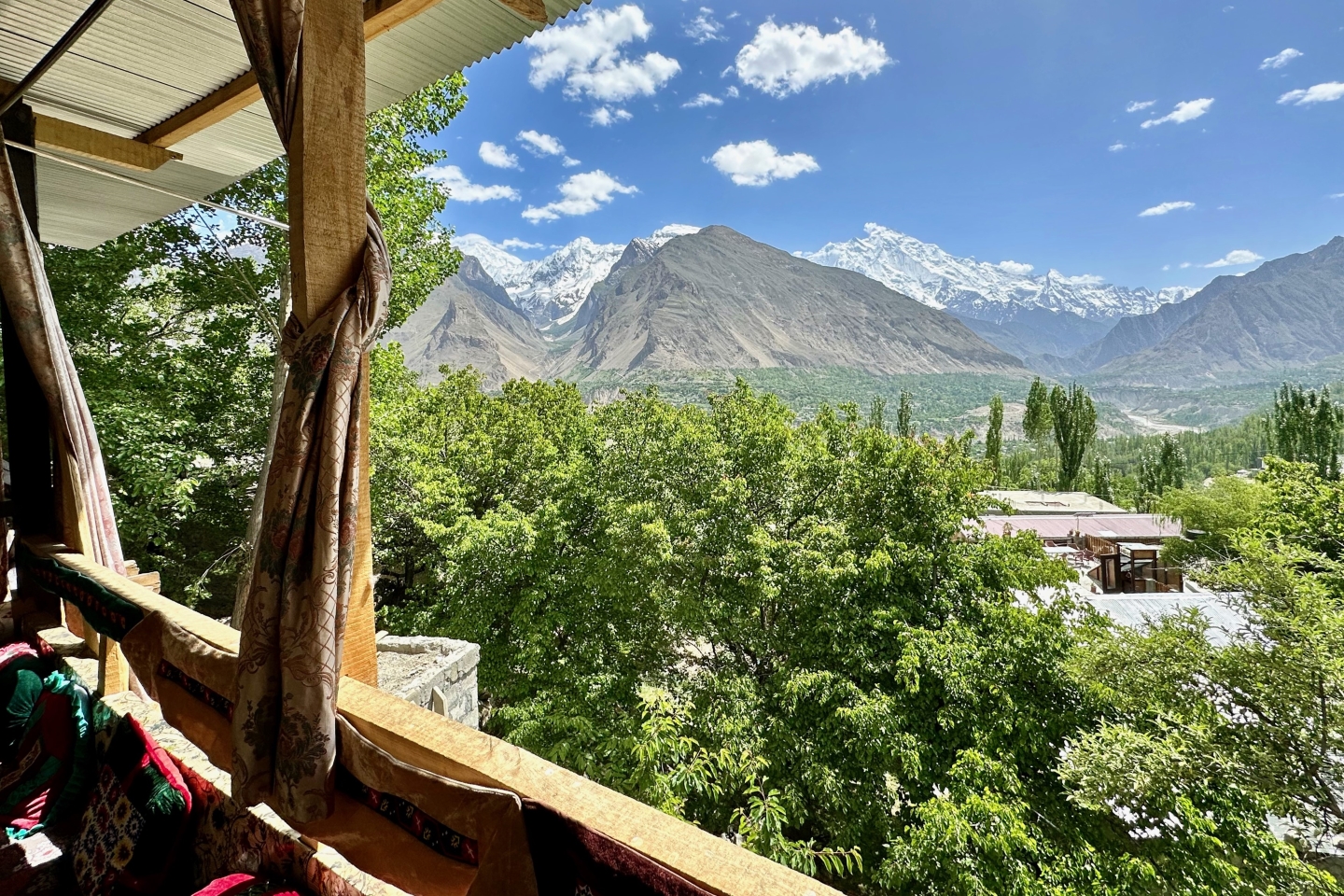
The sprawling Hunza Valley from Hunza Pavilion, a restaurant by the road that serves authentic local dishes including soups, stews and bread (All photos: Kristy Yong)
Pakistan, with its male-dominated society and complex, conservative social values, might not be the most obvious choice for travellers, let alone female ones. But a 12-day drive through the rugged country — starting from the capital city of Islamabad and ending in the former hill station of Rawalpindi, changed all my perceptions of the country and led to one of the most exhilarating adventures of my life, filled with food as rich as the culture and people who I will remember forever as warm, welcoming and wonderfully unforgettable.
Day 1: Islamabad
The day began on a rhythmic note, with breakfast accompanied by a serenade of live music. If only all mornings could start this way, I thought wistfully. Fortified by the delectable hotel spread, we set out to explore Aabpara Market, one of the oldest in Islamabad. It thrived with life and colour, offering everything from clothes and shoes to hardware and household items.
As it began to pour, the market took on an even more vibrant hue, a perfect embodiment of the capital’s lively charm. The rain drove us to take shelter in Centaurus Mall, a sprawling modern structure that contrasts with rustic Aabpara. We browsed Afghan carpets, their intricate patterns weaving tales of an ancient culture.
Our adventure then led us to Rawalpindi, the second-largest city after Islamabad. Here, we visited Raja Bazaar, a bustling space resonating with the hum of commerce. It offered a cornucopia of wares ranging from clothes and shoes to spices and traditional food items.
We took the chance to visit the iconic Faisal Mosque. It was a sight to behold, not just as a place of worship but also a thriving community hub. Children were joyously playing around the water feature, their laughter echoing in the liveliness of the place. The stunning Margalla Hills, as a backdrop, added to the ambience.
As evening descended, we headed to Saidpur Village. We indulged in an authentic Pakistani dining experience at Des Pardes, savouring a variety of traditional dishes, including lamb curries and karahis. The highlight, however, was the chai. Pakistanis’ love of tea is well known, and we couldn’t resist trying the local Doodh Patti (milk tea).
As we returned to the hotel, I reflected on the diverse experiences that Islamabad had offered in just one day — from traditional markets and modern malls to delicious food and heartwarming chai — a symphony of old and new.
pakistan_bazaar.jpg
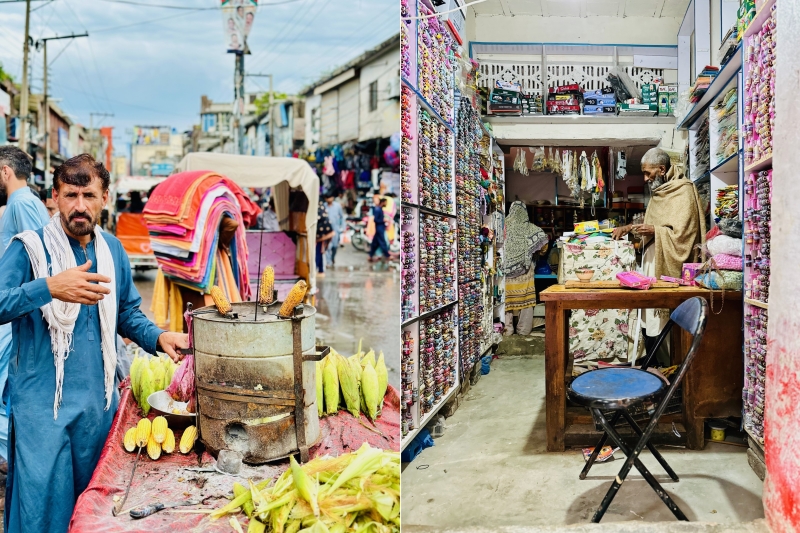
Day 2: Skardu
After a short flight, we touched down at Skardu Airport and walked the grounds of Serena Shigar Fort, where we had a delightful lunch consisting of sumptuous Chicken Handi and Biryani. The local flavours were truly exceptional.
A short drive down into the valley, we discovered Khoj Resort, which had been welcoming guests for just six weeks. This hidden gem proved to be a perfect sanctuary from an unexpected dust storm. Our day continued with visits to the serene Blind Lake and the exotic Sarfaranga Cold Desert, where we enjoyed a mesmerising sunset ride on the dunes.
For dinner, we had Mutton Yakhni, Amacha Kofta (meatball curry), Yagi (a crepe-like dish in spinach sauce) and Sque Balay soup. Each dish offered an array of vibrant flavours that left us wanting more.
Day 3:
Our third day was filled with exploration and relaxation. We were shown around an old village to experience the charm of traditional living. Later, we found ourselves at One Season Restaurant, strategically positioned by a stream. Here, we spent a peaceful afternoon watching the world go by.
The highlight of our day was a visit to the organic fruit garden in Hashupi, Shigar, known for the “five-star” Pakistani apple (its base has five corners, making it look like a star). The garden also offers local cherries, which have a softer texture than what we’re used to, but they are equally sweet.
Day 4:
The sun greeted us as we started our journey from Shigar to Shangrila. We had a pleasant stop at Safari Resort for lunch in the garden. What was interesting was that every meal was made from scratch and took at least an hour to prepare. We used up the free WiFi pretty quickly (all foreign networks with unlimited business plans had no connectivity from the time we left Islamabad).
Our journey then took us through Soq Valley, which showcased nature’s beauty at its best. The real adventure of the day was the 10-minute hike down to Upper Kachura Lake. Although steep and uneven, the trek was worth every step, as we were rewarded with an idyllic spot at which to bask in the sun. Squint a little less and you might just be on the “Amalfi Coast of the East”.
img_7960.jpg
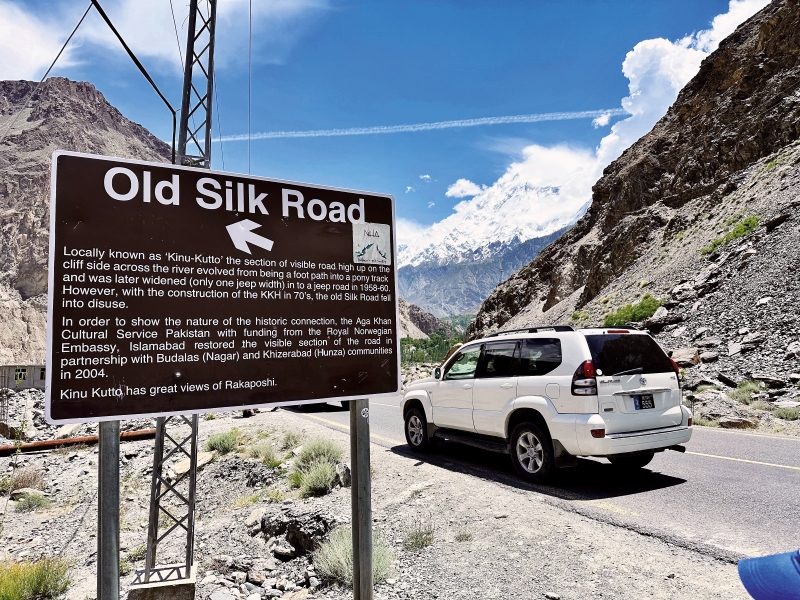
Day 5: Gilgit
It was a sun-soaked day at a pleasant 16°C as we journeyed from Kachura to Gilgit — a city in the Gilgit-Baltistan region. Serving as the region’s capital and situated along the ancient Silk Road, Gilgit is a trade, commerce and administration hub. It took us alongside the majestic Indus River, which flows from Tibet and makes its way through to the Arabian Sea, spanning over 2,200km.
We stopped at Astak Nala, a lovely little spot, to take in the scenery. The journey was marked by the constant scent of gasoline from the bustling road and an unusual aroma of spices that seemed to be emanating from my skin, after days of overindulging in the sumptuous local cuisine. We passed by the quaint Dambudass Village. The drive from Shangrila to Gilgit, covering a distance of 176km, was filled with captivating sights.
Serena Gilgit was our home for the night. The lush grounds were welcoming, and we spent some time walking around. Our arrival was not without hiccups, though. We experienced four power cuts — alternating between the main supply and generator set — within the first 20 minutes. To recover from the day’s journey, I decided to have a lie-in, with some room service and Netflix.
Day 6: Hunza Valley
Gilgit-Baltistan is an administrative territory in the northernmost part of the country, bordering China to the north, Afghanistan to the west, Tajikistan to the northwest and Kashmir to the south. It is known for its striking natural beauty, with rugged mountains, pristine lakes and diverse flora and fauna.
We embarked on our journey at the beginning of the famous Karakoram Highway that would take us to Hunza Valley. After 100km, we reached Karimabad, and managed to spot traces of the Old Silk Road. It felt like we had travelled back in time. We stopped at the Rakaposhi viewpoint, standing 7,788m above sea level, for an incredible view. From the “Mother of Mist” or “Mother of Clouds” on clear days, you can see several tall peaks in the Karakoram Range, including Rakaposhi, Ultar Sar and Ladyfinger Peak (this peak is often photographed due to its dramatic shape).
We had a leisurely and hearty lunch of Chapshuro (often called the Hunza Pizza — bread filled with chopped beef or chicken, onions, green chilies and fresh herbs) after being educated on gemstones by Mohamed, who speaks fluent Mandarin and runs one of the mines we had driven past the day before. Later, we checked into Offto, a welcoming place indeed. There’s something about the unfiltered mineral-packed river water here that leaves your skin super smooth. Hunza water is known for its purity and mineral content and is said to contribute to the longevity of the local people.
After an exploration of Karimabad Bazaar, we stopped for a refreshing break at Cafe de Hunza for Hunza tea with honey and managed to pick up some local crafts at the Karakoram Craft Shop. The day ended with a simple dinner. Back at the hotel, an orchard party awaited us.
img_8294.jpg
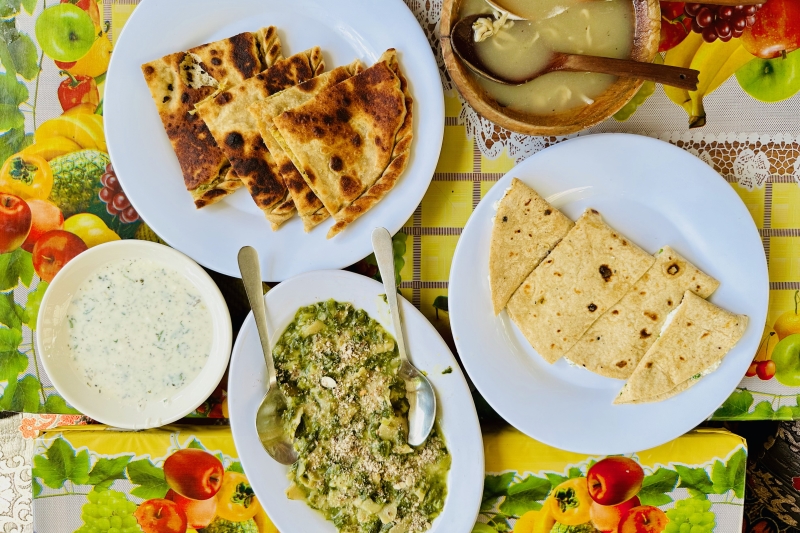
Day 7:
A bright and early morning start saw us moving our base to Hunza Darbar Hotel, which promised a change of scenery. The day’s highlights included visits to the historic Baltit Fort and Serena Altit Fort, both brimming with rich history. Amid these explorations, we squeezed in lunch at Pizza Pamir. We also got to visit the Agricultural Bazaar, sampled some of the local spread, found some delicious dried seedless cherries and watched children dancing along the streets. The Eagle’s Nest viewpoint presented us with an unforgettable panoramic sunset. The way the changing light played across the valley and on the snow-capped peaks was truly breathtaking.
Day 8:
We started the day with lunch at Hunza Pavilion — a restaurant by the road with amazing views — partaking in authentic local dishes including soups, stews and bread. Of note was Dowdo, a hearty, nutritious soup often consumed in colder weather. Made with homemade wheat noodles, meat (typically chicken or beef) and vegetables like carrots, peas and potatoes, the soup is flavoured with local herbs and spices. This dish offers necessary warmth and energy to residents of the mountainous region during the cold winter months.
The afternoon was spent shopping for unique stones and kilims. The day concluded with a flavourful barbecue dinner at Dawat e Hunza, during which we tried Giye. Also known as Hunza bread, it is a dense, slightly sweet, whole-grain bread filled with a variety of seeds and nuts.
img_8381.jpg
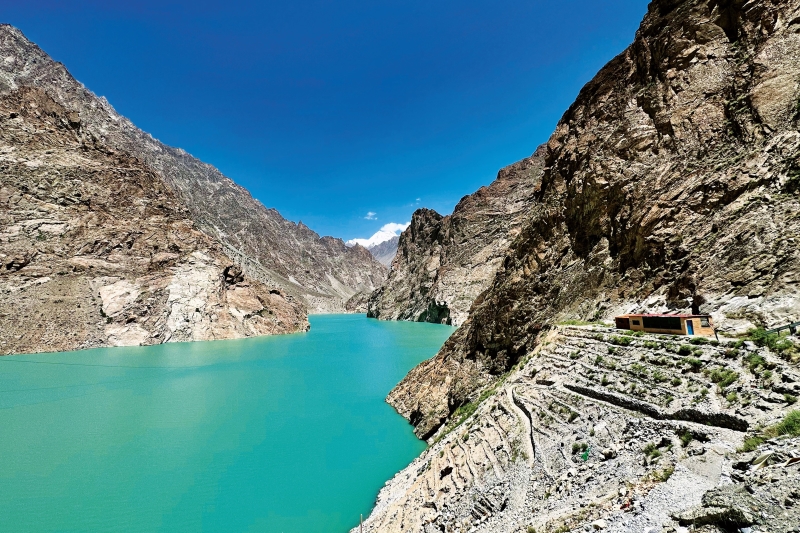
Day 9:
We left Karimabad for Gulmit, travelling on the Karakoram Highway. The scenic beauty along the way was breathtaking, with the Karakoram Range towering above us. We made a stop at Lake Attabad, turquoise and mesmerising, formed after a massive landslide in 2010. Its colours were surreal and left us in awe of nature’s wonders. Later, we headed to Ordoo Path, an elevated viewpoint, for the sunset.
Our accommodation for the night was Silk Route Lodge, or SRL — Route 16, a place full of purpose and noble causes. The home-cooked meal by the founder’s family chef, who hails from Karachi, delighted our tastebuds, especially after days of not having many vegetable options. We savoured the rich flavours of Masala Aubergine, Vegetable Pulao Rice, Stir-fried Okra, Naan with Hummus, Beef Karahi and Potato Patties.
Day 10:
It was a day of choices. We were torn between the allure of the mystical Khunjerab Pass and the charms of Karimabad. Our original itinerary had included Khunjerab Pass, but due to the altitude and time constraints, we decided to save it for another trip.
Over breakfast at the lodge, we met Sobia, the founder of SRL, who took over the lodge after the local Gulmit community told her about the lease coming on the market. Fully embracing the spirit of a purposeful life, she balances her remote work in fintech while managing SRL with a dedicated team. The Karachi native actively contributes to the impressive 95% literacy rate in Gulmit and even initiated a community exchange programme with the renowned Kennedy School in the US.
Around noon, we embarked on a 20-minute hike to explore the legendary Hussaini Bridge, which is a testament to human resilience and craftsmanship. Walking on stones, we attempted to reach Borith Lake, but the scorching midday sun made us retreat. We made a quick stop at the Passu Glacier before returning to SRL for lunch and the journey back to Karimabad.
img_8497.jpg
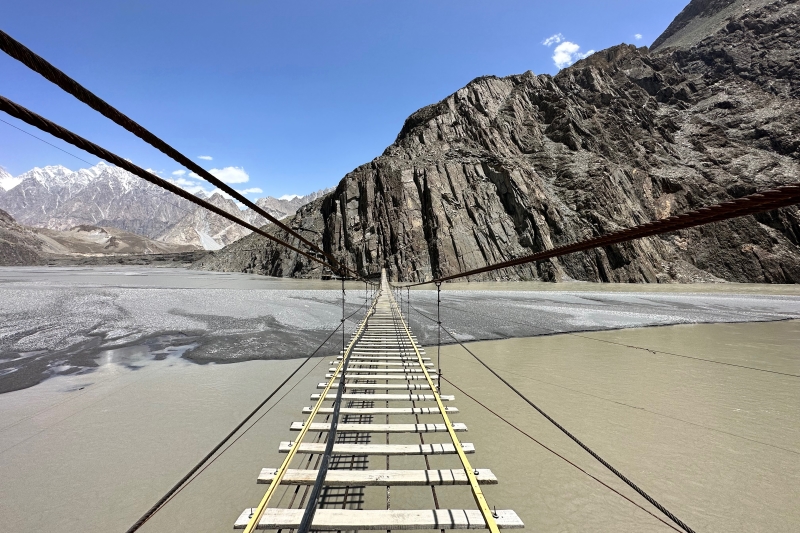
Day 11:
The day began with an early drive back to Gilgit. Our destination was Islamabad, where we would spend a night before making our way back to Kuala Lumpur via Bangkok. Our flight was scheduled for 11.30am, but due to some delays, it wasn’t until 12.45pm that we were in the air.
The wait at the airport was an experience in itself. The drivers were on standby until the flight took off — a protocol for propeller planes as they might not be able to take off due to weather or technical conditions. After a relatively smooth journey, we arrived in Islamabad but alas, our luggage was nowhere in sight.
Day 12:
Our final day in Pakistan began on a sweet note with a pleasant update, thanks to our Apple AirTags. To our relief, our lost luggage had been found. After retrieving that from the airport, we headed to Shinwari for lunch. This unique dining place allows you to choose your cut of meat, which is then prepared in a traditional Butt Karahi. We thought we were ordering mutton, but ended up with Desi Murgh, a local breed of cockerel. Surprisingly, the mix-up led to an interesting discovery, a fitting metaphor for our entire journey in Pakistan — full of unexpected twists but incredibly enriching at every turn.
As we prepared to bid farewell to Islamabad and, indeed, Pakistan, memories of our incredible experiences and the inspiring people we had met filled us with deep gratitude. The country’s scenic beauty and rich heritage captivated us, but it was undoubtedly the unparalleled warmth and friendliness of its people that truly made our visit unforgettable. As the saying goes, you arrive in Pakistan seeing it as a place, but you leave seeing it as a people — warm, welcoming and wonderfully unforgettable.
This article first appeared on Mar 4, 2023 in The Edge Malaysia.


